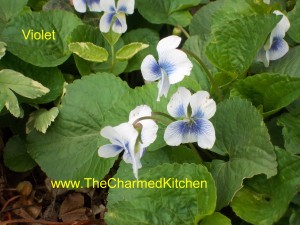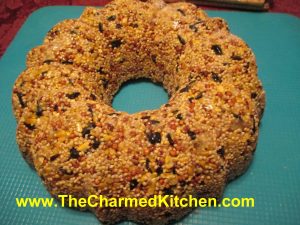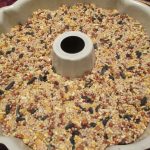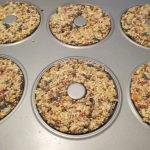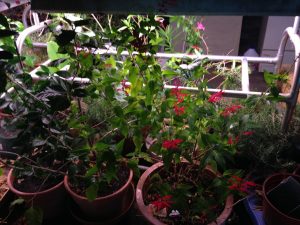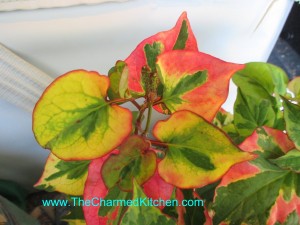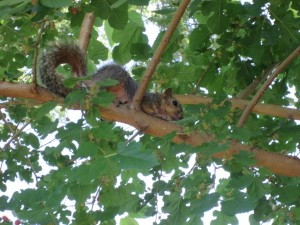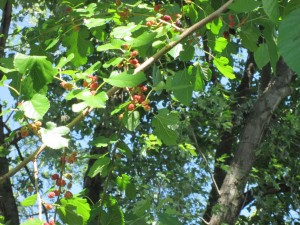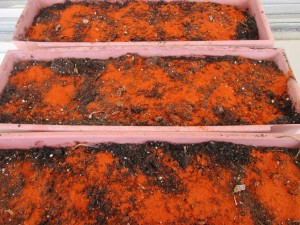The Sinister Garden
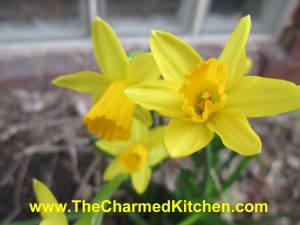 Did you know that daffodils are poisonous? They are.
Did you know that daffodils are poisonous? They are.
I am always encouraging people to forage. There are so many common plants that are both edible and tasty. As the new season, starts I also want to be a little cautionary. As much as there are common plants out there that can nourish you, there are also common plants that are dangerous and even deadly.
Be sure you know what the plant is. If you can’t identify it for sure, find someone who can. Your local Extension office can help.
There are also plants where some parts are edible and others not -like tomatoes. Potatoes are wonderfully edible, but the foliage on potato plants is poisonous. There are also plants that are only edible in certain stages of growth or when prepared a certain way. If you aren’t sure- don’t eat it!!!!
While this is not meant to be a complete list here are some plants you should watch out for. Even more true if you have small children, or pets that might ingest them. Some are quite toxic, others might cause skin irritations etc.
Some Poisonous Plants
Bryony (Bryonia): all parts are poisonous, Boxwood (Buxus),: contact with the sap may irritate skin, Christmas rose, Lenten rose, hellebore (Helleborus): all parts may cause severe discomfort if ingested and the sap may irritate skin, Clematis, old man’s beard, virgin’s bower (Clematis): all parts are poisonous, causing mouth pain if eaten and minor brief skin irritation, Columbine (Aquilegia): contact with the sap may irritate skin, Comfrey (Symphytum): roots and leaves may cause severe discomfort if eaten and leaves may irritate skin, Daffodil (Narcissus): bulbs toxic if eaten in large quantities; skin may be irritated by handling bulbs, flowers and stems, Elder (Sambucus): all parts may cause severe discomfort if ingested and the leaves may irritate skin, False acacia (Robinia preudocacia): all parts may cause severe discomfort if eaten, Foxglove (Digitalis): all parts may cause severe discomfort if ingested and the leaves may irritate skin, Ivy (Hedera): all parts may cause discomfort if eaten and the sap or airborne hairs may aggravate allergies and irritate skin, Juniper (Juniperus): contact with foliage may irritate skin allergies, Lobelia (Lobelia): the sap may irritate skin, Lily of the valley (Convallaria majalis): seeds can cause stomach upset, Lords and ladies (Arum): all parts may cause severe discomfort if ingested and the sap may irritate skin, Lupine (Lupinus): the seeds may cause severe discomfort if ingested, Mountain laurel (Kalmia): all parts may cause severe discomfort if eaten, Potato, potato vine, false Jerusalem cherry, eggplant (Solanum): toxic compounds causing weakness and confusion are concentrated in stems, leaves, sprouts and fruits. They are increased by exposure to light, damage and age. Levels are kept low in food varieties and the compounds are mostly destroyed by cooking. Privet (Ligustrum): all parts may cause severe discomfort if eaten, Rhubarb (Rheum): leaves may cause discomfort if ingested. Use only the leaf stalk in recipes. Windflower (Anenome): contact with the sap may irritate skin, Wisteria (Wisteria): all parts may cause severe discomfort if ingested
Some Poisonous Flowers
Aconite, Anemone, Anthurium, Atamasco Lily, Autumn Crocus, Azalea, Baneberry, Black Locust, Bloodroot, Boxwood, Burning Bush, Buttercup, Butterfly Weed, Caladium, , Carolina Jasmine, Castor Bean, Cherry Laurel, Chinaberry, Christmas Rose, Clematis, Daffodil, Deadly Nightshade, Death Camas, Delphinium, Dogbane, Dumbcane, Elephant Ears, False Hellebore, Four O’clock, Foxglove, Gloriosa Lily, Golden Chain Tree, Goldenseal, Heavenly Bamboo, Henbane, Horse Chestnut, Horse Nettle, Hyacinth, Hyacinth Bean, Hydrangea, Iris, Ivy, Jack-in-the-Pulpit, Jerusalem Cherry, Jessamine, Jetbead, Jimsonweed, Jonquil, Kentucky Coffee Tree, Lantana, Larkspur, Leopard’s Bane, Lily of the Valley, Lobelia, Marsh Marigold, May Apple, Mescal Bean, Mistletoe, Morning Glory, Mountain Laurel, Nightshade, Oleander, Periwinkle, Philodendron, Pittosporum, Poison Hemlock, Potato, Privet, Rhododendron, Rock Poppy, Schefflera, Spring Adonis, Spurge, Star of Bethlehem, Sweet Pea, Tobacco, Trumpet Flower, Water Hemlock, Wild Cherry, Wisteria, Yellow Allamanda, Yellow Oleander
Edible Flowers
When deciding which flowers to plant in your yard- why not plant flowers that are also edible? That way they do double duty. They make your yard look beautiful and they can make your food look beautiful, too.
I cook a lot with flowers. I often add them to salads, infuse vinegars and make jelly with them. You can also use them to decorate cakes or other desserts, in salad dressings and marinades, floating in tropical cocktails, in punch bowls and in ice cubes.
Flowers can also top off dips, cheese, fruit trays and other appetizers, be used to make teas, infused in honey or mixed with soft cheese and spread on crackers or toast.
Add some to baked goods like quick breads, cookies and muffins or in yogurt, cottage cheese or sorbet. Wherever your food needs a little color or flavor, flowers make it special.
Below are 2 lists- one of edible flowers- the other a list of flowers that are poisonous. I would be remiss if I didn’t caution you about flowers that are not edible. Be sure to get a positive identification of any flower before you eat it. Only eat flowers that have been grown pesticide free.
Some Edible Flowers
Calendula, Chives, Daylily, Mint, Nasturtium, Pansy, Rose, Sage, Signet Marigold, Squash Blossoms, Anise Hyssop, Apple, Arugula, Basil, Bee Balm, Borage, Broccoli, Chamomile, Chicory, Chrysanthemum, Coriander, Dandelion, Dianthus, Dill, Elderberry, English Daisy, Evening Primrose, Fennel, Garlic Chives, Hibiscus, Honeysuckle, Hyssop, Jasmine, Johnny-Jump-Up, Lavender, Lemon, Lilac, Linden, Marjoram, Mustard, Nasturtiums, Nodding Onion, Okra, Orange, Oregano, Pea, Pineapple Guava, Pineapple Sage, Radish, Red Clover, Redbud, Rose of Sharon, Roselle, Rosemary, Runner Beans, Sage, Safflower, Scented Geraniums, Shungiku, Society Garlic, Sunflower, Sweet Woodruff, Thyme, Tuberous Begonia, Tulip, Violet, Winter Savory, Yucca
Some Poisonous Flowers
Aconite, Anemone, Anthurium, Atamasco Lily, Autumn Crocus, Azalea, Baneberry, Black Locust, Bloodroot, Boxwood, Burning Bush, Buttercup, Butterfly Weed, Caladium, Call, Carolina Jasmine, Castor Bean, Cherry Laurel, Chinaberry, Christmas Rose, Clematis, Daffodil, Deadly Nightshade, Death Camas, Delphinium, Dogbane, Dumbcane, Elephant Ears, False Hellebore, Four O’clock, Foxglove, Gloriosa Lily, Golden Chain Tree, Goldenseal, Heavenly Bamboo, Henbane, Horse Chestnut, Horse Nettle, Hyacinth, Hyacinth Bean, Hydrangea, Iris, Ivy, Jack-in-the-Pulpit, Jerusalem Cherry, Jessamine, Jetbead, Jimsonweed, Jonquil, Kentucky Coffee Tree, Lantana, Larkspur, Leopard’s Bane, Lily of the Valley, Lobelia, Marsh Marigold, May Apple, Mescal Bean, Mistletoe, Morning Glory, Mountain Laurel, Nightshade, Oleander, Periwinkle, Philodendron, Pittosporum, Poison Hemlock, Potato, Privet, Rhododendron, Rock Poppy, Schefflera, Spring Adonis, Spurge, Star of Bethlehem, Sweet Pea, Tobacco, Trumpet Flower, Water Hemlock, Wild Cherry, Wisteria, Yellow Allamanda, Yellow Oleander, Yesterday, Today and Tomorrow.
Neither of these lists in meant to be complete. Most important of all is to be sure you can identify these plants. If you are unsure plant identifications can be done at your local Extension office, garden center, nursery, arboretum and botanical garden. When in doubt, err on the side of caution. There are more than enough easy to identify flowers out there to enjoy without taking chances.
10 Common Plants You Can Eat
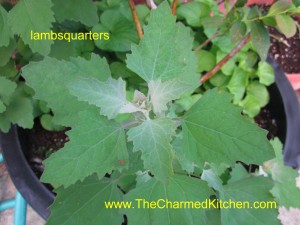 A lot of people don’t realize how many common plants they can eat. I thought it might be fun to share a few of them with you. Some of these are plants we grow as landscape/ornamental plants. Others are more often thought of as “weeds”. All have one thing in common. They are edible.
A lot of people don’t realize how many common plants they can eat. I thought it might be fun to share a few of them with you. Some of these are plants we grow as landscape/ornamental plants. Others are more often thought of as “weeds”. All have one thing in common. They are edible.
Some you may already know. I hope I might show you a few edibles you didn’t know about before.
I tried to stick to plants that were easy to identify. If you are not sure what it is – don’t eat it. Don’t eat plants where pesticides have been sprayed, either.
With any luck, you have at least a few of these in your yard.
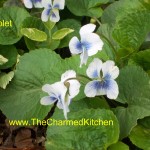 Violets: Violet flowers are edible and used to decorate pastries and to make jelly. Did you know you can also eat the leaves? They are mild flavored- especially when young- and are a great addition to salads. Violet leaves are also high in vitamin C.
Violets: Violet flowers are edible and used to decorate pastries and to make jelly. Did you know you can also eat the leaves? They are mild flavored- especially when young- and are a great addition to salads. Violet leaves are also high in vitamin C.
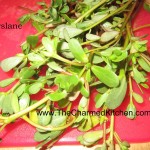 Purslane: The thick, fleshy leaves of purslane are easy to identify. Many vegetable gardeners make every effort to keep them out of their yards. Truth is, purslane is grown as a vegetable in many parts of the world. The leaves can be eaten raw in salads, can be cooked in a stir fry or just steamed as a fresh veggie. They can also be pickled. I make a salsa out of purslane leaves. They are crunchy with a slightly citrus flavor.
Purslane: The thick, fleshy leaves of purslane are easy to identify. Many vegetable gardeners make every effort to keep them out of their yards. Truth is, purslane is grown as a vegetable in many parts of the world. The leaves can be eaten raw in salads, can be cooked in a stir fry or just steamed as a fresh veggie. They can also be pickled. I make a salsa out of purslane leaves. They are crunchy with a slightly citrus flavor.
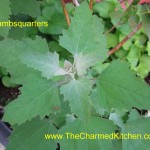 Lambsquarters: Lambsquarters are one of my favorites. They sprout all over my yard and in pots as soon as the weather warms up in the Spring. The leaves can be eaten raw when young or cooked as they mature. They taste just like spinach and are even better for you. Plants can get quite large and provide an easy harvest of nutritious greens.
Lambsquarters: Lambsquarters are one of my favorites. They sprout all over my yard and in pots as soon as the weather warms up in the Spring. The leaves can be eaten raw when young or cooked as they mature. They taste just like spinach and are even better for you. Plants can get quite large and provide an easy harvest of nutritious greens.
 Dandelions: We spend so much money trying to kill them. Sad because they are really a tasty green. Dandelions were brought to America by European immigrants as a vegetable. Their bitter greens can be an acquired taste. By combining the greens with certain foods you make them taste less bitter. Starchy foods like breads or potatoes, dairy products, tomatoes and vinegars all seem to tame the bitterness. Dandelion greens can be eaten cooked or raw. Flowers are used to make jelly and wine and can be added to baked goods.
Dandelions: We spend so much money trying to kill them. Sad because they are really a tasty green. Dandelions were brought to America by European immigrants as a vegetable. Their bitter greens can be an acquired taste. By combining the greens with certain foods you make them taste less bitter. Starchy foods like breads or potatoes, dairy products, tomatoes and vinegars all seem to tame the bitterness. Dandelion greens can be eaten cooked or raw. Flowers are used to make jelly and wine and can be added to baked goods.
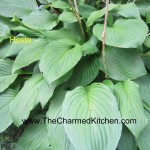 Hosta: If you can get to them before the deer do, you will be pleasantly surprised. Hosta leaves are quite mild flavored, similar to Bibb lettuce. I add them to salads and even serve them with dips. The older leaves get tough so pick young leaves.
Hosta: If you can get to them before the deer do, you will be pleasantly surprised. Hosta leaves are quite mild flavored, similar to Bibb lettuce. I add them to salads and even serve them with dips. The older leaves get tough so pick young leaves.
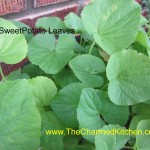 Sweet Potato Leaves: A friend from Hawaii first told me about eating sweet potato leaves. The leaves are pretty mild flavored. I normally eat them cooked although I have friends that eat them raw as well. You can eat the leaves of all sweet potatoes, including ornamental types.
Sweet Potato Leaves: A friend from Hawaii first told me about eating sweet potato leaves. The leaves are pretty mild flavored. I normally eat them cooked although I have friends that eat them raw as well. You can eat the leaves of all sweet potatoes, including ornamental types.
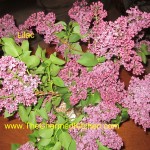 Lilac: Lilac flowers are fragrant and edible. I use them every year to make lilac infused vinegar. They have a nice spicy taste that works well in the vinegar. Blossoms can be added to salads, too. This year I also made lilac jelly.
Lilac: Lilac flowers are fragrant and edible. I use them every year to make lilac infused vinegar. They have a nice spicy taste that works well in the vinegar. Blossoms can be added to salads, too. This year I also made lilac jelly.
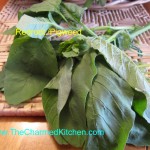 Redroot/Pigweed: This member of the amaranth family is distinguished by a reddish color to its roots. It has a spinach like flavor and can be cooked and used like spinach is any recipe. The plants can get several feet tall and often show up in places where the soil has been tilled.
Redroot/Pigweed: This member of the amaranth family is distinguished by a reddish color to its roots. It has a spinach like flavor and can be cooked and used like spinach is any recipe. The plants can get several feet tall and often show up in places where the soil has been tilled.
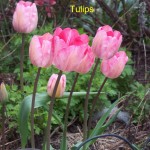 Tulips: Tulips are more than pretty, they are also quite tasty. The petals taste like a mild flavored lettuce and can add a beautiful touch to salads. The bulbs are also edible but we rarely eat them because to do so would destroy the plant. The petals, however, can be harvested and eaten year after year without harming the plant.
Tulips: Tulips are more than pretty, they are also quite tasty. The petals taste like a mild flavored lettuce and can add a beautiful touch to salads. The bulbs are also edible but we rarely eat them because to do so would destroy the plant. The petals, however, can be harvested and eaten year after year without harming the plant.
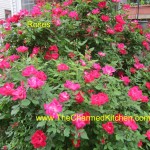 Roses: Rose petals have been used to make fragrances for a very long time. The petals are also edible and can be added to salads and used to make jelly, syrup and of course, rose water. The hips are also quite edible. Rose hips are the round balls that are left after the bloom is spent. They are full of vitamin C and can be cooked and used to make tea and jelly.
Roses: Rose petals have been used to make fragrances for a very long time. The petals are also edible and can be added to salads and used to make jelly, syrup and of course, rose water. The hips are also quite edible. Rose hips are the round balls that are left after the bloom is spent. They are full of vitamin C and can be cooked and used to make tea and jelly.
This is far from a complete list. Just a few things from my yard that I thought you might have, too.
Bird Seed Wreaths
If you feed the birds, like I do, you might enjoy this idea. My friend Dale posted a recipe for making these bird seed wreaths on my wall. I had recounted my frustration on trying to fill my bird feeder on a very windy day. He thought these might be a solution. He was right. They are also fun to make.
This recipe comes from a website called Garden Answer.
My first attempt, I didn’t follow the recipe exactly. The wreath, while pretty, was a little crumbly. The birds still loved it, though. I didn’t hang it up, as the original post suggested. I have a porch with a wide concrete ledge, so I just put it on the ledge. It was gone in a day and a half.
I decided to try again, this time following the recipe. They came out great. Nice and sturdy.
I made two different sizes the second time. I made one large one, then made a second batch of the seed mixture and made 12 smaller ones as well. Not only are these a nice way to feed the birds, it can be a fun craft project for kids and they would be a nice gift for a bird lover.
Once dried, you can tie a ribbon on them and hang in a tree- or just hang on a hook. I have several shepherd’s hooks in my yard and would use them.
Not sure how well they would hold up in rainy weather, but should hold up well on snowy days.
So here is the recipe. You could add some peanuts or dried fruit for more variety.
Bird Seed Wreaths
2 packets unflavored gelatin- or two tablespoons
1 c. warm water
6 T. light corn syrup
1 1/2 c. flour
8 c. bird seed
Grease a full sized Bundt pan or 12 small ones. You can use a non-stick spray or lightly brush with oil. Set aside. In large bowl, combine the gelatin and warm water and stir until gelatin is dissolved. Stir in the corn syrup, then the flour and mix well. Stir in the birdseed and make sure it gets evenly coated with the gelatin mixture. Press mixture into prepared pan. Press firmly. This part is important. Pressing firmly gives you a firmer final product. Allow the wreaths to dry for 24 hours before un-molding. To hang you can tie on a ribbon or place on a hook. You can also place them on platform feeders.
Winter Plant Care
Since I just brought in a lot of plants for winter, I have been getting questions about how to help them make it through winter. I have an ideal set up at my house. I have a basement and two large grow carts, so my plants are in a good environment for them.The basement will be more humid than the rest of the house. Since Ohio winters have little daylight, the artificial light makes a big difference.
An added advantage is I will be able to harvest fresh herbs all winter.
You can keep plants alive in your house, outside of the basement, but it is trickier.
Creating the right environment it critical to the survival of any plant. In the winter this is a little harder than during the summer. Still, with a little planning you can have plants that will last for years.
Plants all need: Water, air, food and light
Pick out plants that are likely to be happy in your home. Remember, your plant has probably come from a greenhouse under ideal conditions, or it has been outside, getting plenty of natural light. It is normal for new plants to go through a period of adjustment.
Pick plants with low-light requirements if your home does not have a lot of windows.
If you don’t like to water plants often pick plants like cacti and succulents that don’t need to be watered often.
The air in your house will be pretty dry in winter. If you get sparks from static electricity your house is dry. Misting plants will only provide moisture for 30 minutes or so. Place plants on trays, filled with rocks. Then fill the tray with water. This gives your plants moisture. Be sure the plants are above the water level, not sitting in the water. That is the reason for putting rocks in the trays. The plants sit on the rocks above the water.
Assuming you don’t have artificial light…..
1. During winter months when light is less, reduce the amount of water plants receive and use little or no fertilizer.
2. Place plants away from drafts and heat sources.
3. Do not allow plants to touch windows.
4. Do not allow plants to stand in water.
5. Keep the humidity up around the plants.
6. Consider supplementing natural light with artificial light.
7. If you set plants outdoors for the summer, bring them in when indoor and outdoor temperatures are the same.
8. Always check plants that are outdoors for insects before bringing in. You can give them a spray of water before bringing them in, to wash off insects.
9. Keep any new plant away from your other plants until you are sure it is disease free.
10. As the days begin to lengthen you can start to use fertilizer again.
Again, artificial light is a great idea. If you can’t provide it, then let your plants be semi dormant during the shorter days of winter.
Plants for Sale
I have been teaching cooking classes all week in Mentor. Every day this week as I pull out of the parking lot at Wildwood after class I pass a house with a Plants for Sale sign out front. The sign says .50-$1.00. I decided to stop today after class. What a fun time I had. It isn’t a business, just a person selling a few plants. They have mostly perennials, many that like shade. Daylilies, hostas, several different ground covers, giant marigolds. Most things are in the 1-2 dollar range, some are 50 cents.
I got a plant called the Chameleon Plant. It is a shade and moisture loving ground cover that by some accounts can be invasive. I have a friend who has grown it for years and says it is not a problem for her. It is also edible. I am planning on making a shady area I have more edible plants so adding hosta and more daylilies to my yard.
The lady was very nice so I thought I’d pass on the info if any of you are interested. I don’t have the exact address. Pretty sure it is 7742 Little Mountain Road in Mentor. Its just across the street from Wildwood and has a big sign so hard to miss even if the address is wrong.
Mulberries and the Squirrel
I was so excited to see how many mulberries I have this year. The tree is pretty tall now so I’ll need to get out a ladder to get many of them, but there are still plenty at arm’s reach. I had visions of mulberry pie or tart. Perhaps some jam or jelly. Yum. I was out taking pictures of the higher fruit when I spied a little visitor. The squirrel was just sprawled out all cozy. He obviously had no interest in going anywhere. All I could think of was that he had the same thing on his mind- those berries. Well, most aren’t ripe yet, but I’ll scale down my dreams of a big berry harvest. I have a funny feeling the squirrel is going to be enjoying them, too. I only hope he will keep his harvesting to the ones up high and at least let me get the lower ones!!!
Edible Flowers
I’ve been cooking a lot with flowers lately. I often add them to salads, infuse vinegars and make jelly with them. You can also use them to decorate cakes or other desserts, in salad dressings and marinades, floating in tropical cocktails, in punch bowls and in ice cubes. Flowers can also top off dips, cheese, fruit trays and other appetizers, be used to make teas, infused in honey or mixed with soft cheese and spread on crackers or toast. Add some to baked goods like quick breads, cookies and muffins or in yogurt, cottage cheese or sorbet. Wherever your food needs a little color or flavor flowers make it special. Below are 2 lists- one of edible flowers- the other of flowers that are poisonous. Be sure you know what you are eating-and only eat flowers that have been grown pesticide free.
Some Edible Flowers
Calendula, Chives, Daylily, Mint, Nasturtium, Pansy, Rose, Sage, Signet Marigold, Squash Blossoms, Anise Hyssop, Apple, Arugula, Basil, Bee Balm, Borage, Broccoli, Chamomile, Chicory, Chrysanthemum, Coriander, Dandelion, Dianthus, Dill, Elderberry, English Daisy, Evening Primrose, Fennel, Garlic Chives, Hibiscus, Honeysuckle, Hyssop, Jasmine, Johnny-Jump-Up, Lavender, Lemon, Lilac, Linden, Marjoram, Mustard, Nasturtiums, Nodding Onion, Okra, Orange, Oregano, Pea, Pineapple Guava, Pineapple Sage, Radish, Red Clover, Redbud, Rose of Sharon, Roselle, Rosemary, Runner Beans, Sage, Safflower, Scented Geraniums, Shungiku, Society Garlic, Sunflower, Sweet Woodruff, Thyme, Tuberous Begonia, Tulip, Violet, Winter Savory, Yucca
Some Poisonous Flowers
Aconite, Anemone, Anthurium, Atamasco Lily, Autumn Crocus, Azalea, Baneberry, Black Locust, Bloodroot, Boxwood, Burning Bush, Buttercup, Butterfly Weed, Caladium, Call, Carolina Jasmine, Castor Bean, Cherry Laurel, Chinaberry, Christmas Rose, Clematis, Daffodil, Deadly Nightshade, Death Camas, Delphinium, Dogbane, Dumbcane, Elephant Ears, False Hellebore, Four O’clock, Foxglove, Gloriosa Lily, Golden Chain Tree, Goldenseal, Heavenly Bamboo, Henbane, Horse Chestnut, Horse Nettle, Hyacinth, Hyacinth Bean, Hydrangea, Iris, Ivy, Jack-in-the-Pulpit, Jerusalem Cherry, Jessamine, Jetbead, Jimsonweed, Jonquil, Kentucky Coffee Tree, Lantana, Larkspur, Leopard’s Bane, Lily of the Valley, Lobelia, Marsh Marigold, May Apple, Mescal Bean, Mistletoe, Morning Glory, Mountain Laurel, Nightshade, Oleander, Periwinkle, Philodendron, Pittosporum, Poison Hemlock, Potato, Privet, Rhododendron, Rock Poppy, Schefflera, Spring Adonis, Spurge, Star of Bethlehem, Sweet Pea, Tobacco, Trumpet Flower, Water Hemlock, Wild Cherry, Wisteria, Yellow Allamanda, Yellow Oleander, Yesterday, Today and Tomorrow.
Neither of these lists in meant to be complete. Most important of all is to be sure you can identify these plants. If you are unsure plant identifications can be done at your local Extension office, garden center, nursery, arboretum and botanical garden. When in doubt, err on the side of caution. There are more than enough easy to identify flowers out there to enjoy without taking chances.
Tomatoes and Tobacco
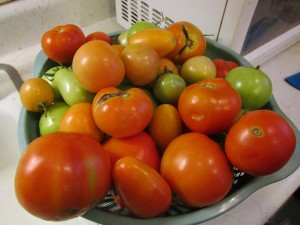 No, this is not a new recipe post. There is a connection between tomatoes and tobacco that you might not know about. It is really good to know if you grow tomatoes and are also a smoker. Some of the tobacco in cigarettes contains a disease called tobacco mosaic virus. Tomatoes are susceptible to this disease. If you are both a tomato grower and a smoker it is important that you wash your hands before going out to the garden or you could transmit this disease to your tomato plants.
No, this is not a new recipe post. There is a connection between tomatoes and tobacco that you might not know about. It is really good to know if you grow tomatoes and are also a smoker. Some of the tobacco in cigarettes contains a disease called tobacco mosaic virus. Tomatoes are susceptible to this disease. If you are both a tomato grower and a smoker it is important that you wash your hands before going out to the garden or you could transmit this disease to your tomato plants.
Some hybrids are resistant to the virus. If there is a letter “T” after your tomato’s name it means it is resistant. Roma tomatoes are resistant. Hybrids will often have other letters after their names like VFNT. Means they are resistant to Verticillium wilt, Fusarium wilt, Nematodes and Tobacco mosaic virus. That is what those letters mean.
So, if you smoke wash your hands before going out to the garden.
Squirrels in the Garden
I actually like squirrels. I think they are kind of fun to watch. The problem is that they can be very destructive in the garden. My problem is mostly with container grown plants this time of year. When the planters are freshly planted, squirrels love to dig them up. I started some pea seeds today for pea shoots. It is still pretty cold here so peas are one of the few crops I can safely plant outside right now. I filled 3 long planters with soil and seeds. I am looking forward to a tasty crop of pea shoots in no time. I’ll also leave some of them into produce peas. To keep the squirrels out I dusted the planters generously with cayenne pepper . Since it seems to keep them out of the bird seed it should work here, too. Birds are not bothered by cayenne so they still eat the bird seed in the feeder. We’ll see if it works. I’ll post updates from time to time to see if this does the trick. What do you find works to keep squirrels and other critters out of your garden? I think it is a problem for a lot of us and would love to hear what works for you.
